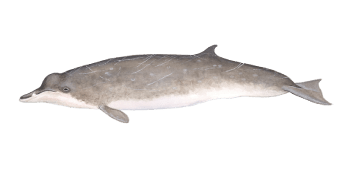
Sowerby’s beaked whale
(Mesoplodon bidens)
This beaked whale is found only in the North Atlantic and was the first of the beaked whales to be discovered (1800). Despite this, very little is known about this species due to the rare encounters.
It is one of the most commonly stranded beaked whales and it was from the dead individuals that the first physical descriptions of the species were made.
The whales have a long, slender beak and a low melon in front of the blowhole. A pair of teeth erupt midway along the beak in adult males. Their dorsal fin is falcate and set behind the middle of the back. When surfacing, the teeth of adult males are visible. Sowerby’s can be seen in mixed groups of up to 10 individuals, including adult males and females with calves.
They are known to dive for at least 28 minutes and share their range with other species such as the True’s, Gervais’ and the Blainville’s beaked whales.
General information
Further names: Portuguese: Baleia-de-bico-de-Sowerby
Size of adults: Males: 5,5 m; Females: 5 m
Prey: Squid, small fish
Behaviour: Surface with their beaks sticking out of the water at a steep angle. Very timid animals that can be surface active, with several observations of breaching individuals.
Range: They have one of the most northerly distribution of all beaked whales: eastern North Atlantic, in the seas around Norway, the UK and Iceland, and in the western North Atlantic off of Canada and Massachusetts, USA. Sowerby’s beaked whales prefer deeper waters and are found offshore past the continental shelf.
Madeira: Very rarely encountered
Distinctive features: Long and spindleshaped body with a small and flat forehead that extends into a long beak with triangular shaped pair of teeth erupting in adult males. They have a relatively small dorsal fin set well back towards the fluke dorsal color is dark bluish grey; underside paler; small blow;
Taxonomy: Suborder: Odontoceti (Toothed Whales); Family: Ziphiidae (Beaked Whales)
Threats: Accidental entanglement in fishing gear, climate change, marine debris, noise pollution. Listed as Data deficient by the IUCN.
